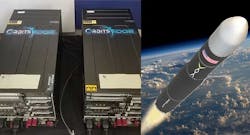Data Centers in Orbit? Space-Based Edge Computing Gets a Boost
Plans to operate small data centers in space got a boost this week, as satellite colocation company OrbitsEdge now has a launch partner. Hybrid rocket startup Vaya Space announced a long-term, exclusive launch agreement with OrbitsEdge, a key step in commercializing the technology for both companies.
OrbitsEdge has developed a compact rack design that will house servers inside a satellite, and has partnered with Hewlett Packard Enterprise and other vendors to create a high-performance computing (HPC) data center to be launched into low-earth orbit (LEO) to process and analyze data being created in space.
It’s one of the most challenging concepts in the evolution of edge computing, which typically seeks to bring data closer to users. OrbitsEdge sees a different business model – analysis and data thinning for the enormous volume of data being generated by next-generation satellites. That includes commercial imaging satellites that are collecting enormous volumes of data.
But first, you have to get the data center into space. That’s where Vaya Space comes in. Vaya was created in 2017 by former Space Shuttle Commander Sid Gutierrez, and has developed an innovative hybrid rocket design using 3D printed fuel grains created from recycled thermoplastics. The company’ tested its launch vehicle in January with a sub-orbital flight from California, and expects its first orbital mission to be in 2023.
“Vaya has gained strong momentum over the past quarter, leapfrogging many of our earlier competitors that approached the space sector with legacy technology,” said Jack Blood, Chief Commercial Officer for Vaya Space. “This is the third major agreement we’ve announced in as many months, as satellite providers have increasingly turned to us to meet their launch needs. We look forward to supporting Orbits Edge as they deploy their new and innovative technology for above-the-cloud, in-space computing.”
The ‘Absolute Extreme of What’s Possible’
OrbitsEdge wants to use edge computing technology to reduce the bandwidth bottlenecks and transmission latency associated with sending vast amounts of satellite data back to Earth for processing. It has worked with server venders like HPE to prototype hardware that can offer a performance boost over current space-based servers, but still operate in a challenging environment.
“OrbitsEdge is the absolute extreme of what is possible with HPE technology,” said Keenan Sugg, solutions architect for HPE. “The fact that you can trust our systems in the ultimate lights-out environment in space speaks volumes.”
OrbitsEdge is able to communicate with other satellites to collect and process their data, as well as perform “overhead” edge computing for terrestrial clients in places where a traditional data center is unavailable. The company sees opportunities in offloading and storing data from Earth Observation satellites, processing it into immediately usable imagery, and sending the results directly to end-users in the field.
One key to this strategy is the OrbitsEdge SatFrame, the company’s proprietary satellite bus, which features a standardized 19-inch server rack with available volume for 5U of hardware. The company’s first two SatFrame pathfinder satellites will support 18-inch deep hardware with production designs capable to grow to support full-sized 36 inch deep hardware.
Here’s a closer look at OrbitsEdge and its ambitions.






